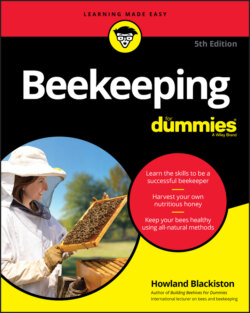Читать книгу Beekeeping For Dummies - Howland Blackiston - Страница 94
HOW TO MOVE A FULL HIVE
ОглавлениеIt’s best not to move hives around unless it’s necessary because it’s disruptive to the bees and a lot of work for you. But sometimes move you must. Here are some helpful guidelines:
Plan to make your move in the evening when the bees are not flying.
Before making the move, tape up any extra entrance or ventilation holes you have drilled in the hive (duct tape works great).
Secure the hive together by using heavy-duty strapping tapes (available at hardware stores). These strapping tapes use a ratchet-type buckle to tighten the straps. Strap the entire hive together as a single unit: bottom board, hive bodies, and cover.
Tape or gently staple a strip of window screening across the front entrance of the hive. Doing so will keep the bees from flying out of the hive (and stinging you) while providing them with adequate ventilation.
Use a hand truck to move the hive (an entire hive can weigh a couple hundred pounds). Get some friends to help.
Wear a veil and gloves in case any bees get loose. I can assure you that they won’t be happy about this move.
Once the hive is in its new location, wait until early the next morning to remove the straps and the entrance screen. This gives the bees time to calm down.
Note: If you are moving bees to a new location that is more than 2-3 miles away, no problem. But if you are moving the hive to a location much less than this, you may lose all of your field bees because they will return to where the hive used to be. If you only need to move your hive a short distance (like across your yard), move the hive a little bit at a time (a yard or two each day) until you reach the desired destination.
If your hive is at the edge of a stream or pond, that’s perfect. But if it isn’t, you should provide a nearby water source for the bees. Keep in mind that they’ll seek out the nearest water source. You certainly don’t want that to be your neighbor’s kiddy pool. You can improvise all kinds of watering devices. Figure 3-4 shows an attractive and natural-looking watering device that I created on top of a boulder that sits in one of my bee yards. All it took was a little cement, a dozen rocks, and a few minutes of amateur masonry skills.
Courtesy of Howland Blackiston
FIGURE 3-4: A shallow bee watering pool that I constructed on a boulder near my hives.
Consider these other watering options: a pie pan filled with gravel and topped off with water, a chicken-watering device (available at farm supply stores; see Figure 3-5), or simply an outdoor faucet that is encouraged to develop a slow drip.
When it comes to providing water for your bees, Figure 3-6 shows a nifty idea that I learned from a fellow beekeeper. Find or purchase a clean pail or bucket. Any size, color, or material will do. Just make sure that it’s clean and has never been used for chemicals, fertilizers, or pesticides. Drill ½-inch drainage holes all around the top edge of the bucket. The holes should be placed about 2 to 3 inches down from the top. Fill the bucket nearly to the holes with water, and then float a single layer of Styrofoam packaging pellets on the surface of the water. The pellets give the bees something to stand on as they sip water. That way they won’t drown. The drainage holes keep rainwater from overflowing the bucket and washing away the pellets. Neat, huh?
You can use a hive-top feeder, filled with water (not syrup) as a convenient way to provide your colony with water.
Courtesy of Howland Blackiston
FIGURE 3-5: A chicken waterer is a great way to provide your bees with water. Place some gravel or small pebbles in the tray so the bees don’t drown.
Courtesy of Howland Blackiston
FIGURE 3-6: The clever bucket-and-packing-pellets solution is a great do-it-yourself watering device.
